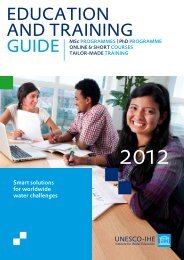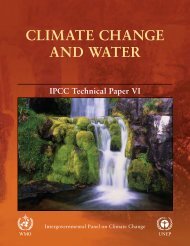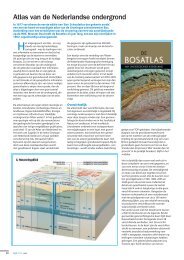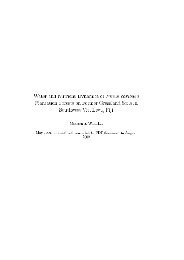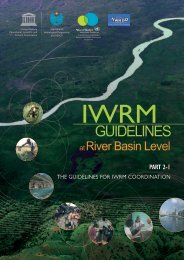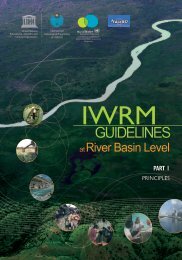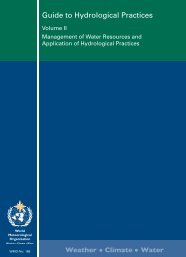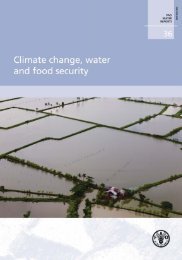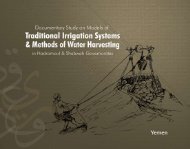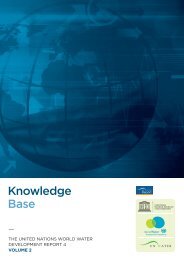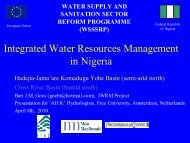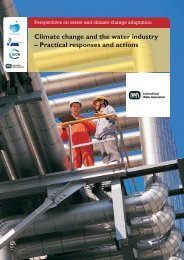Non-renewable groundwater resources: a ... - unesdoc - Unesco
Non-renewable groundwater resources: a ... - unesdoc - Unesco
Non-renewable groundwater resources: a ... - unesdoc - Unesco
- No tags were found...
You also want an ePaper? Increase the reach of your titles
YUMPU automatically turns print PDFs into web optimized ePapers that Google loves.
CHAPTER 5 ■ REGIONAL CASESIn the Continental Intercalary, CI, the scenario zero will result in drawdowns more than40 meters within the Algerian Sahara lower part over the 50-year period. In Tunisia, the drawdownsare approximately 20 to 40 meters and in Libya they are approximately 25 meters. In theComplex Terminal, CT, in Algeria and in Tunisia, the drawdowns exceed 30 meters and in Libyathey reach 60 meters. The disappearance of all artesian flow in the Algerian-Tunisian Chottsregion, with the risk of saline waters intrusion from the Chotts recharge into the CT’s aquifer.Hence the continuation of the current withdrawal schedule, scenario zero, constitutes a majorpotential danger within the region.Assuming the strong policy in Algeria, the CI drawdowns are 300 to 400 meters within theAlgerian Sahara lower part, with the complete disappearance of artesian flow. Libya is notaffected by this policy but in Tunisia the drawdowns are from 200 to 300 meters and the disappearanceof artesian wells and the Tunisian outlet are notable. For the CT, there is no effect inLibya, little effect in Algeria, and recharge may occur in the Chotts region.Assuming the weak policy in Algeria, the effects in Algeria and Tunisia are very strong andquite unacceptable with respect to the CI and the CT.Libyan scenarios of the GMRP in Ghadames resulted in CI drawdowns of 100 meters to thecollecting field, around 50 meters within the deep southern region of Tunisia and in Deb Deb,Algeria. For the collecting field of the Jebel Hassaounah, its impact on the CI remains negligible.These exploratory simulations have highlighted the harmful effects and the risks to whichwater <strong>resources</strong> in this basin are exposed. Continued exploitation of the CI and CT aquifers willrequire managing these risks, which may be summarized, as:● disappearance of artesian flow,● excessive drawdowns in pumped wells,● drying up of Tunisian outlet,● excessive interferences of drawdowns among countries,● potential recharge in the Chotts.A coordinated extraction policyAt the completion of the exploratory simulations, the adopted principle has been to seek thebuilding of extraction patterns founded upon NWSAS output capacities while minimizing theidentified risks of harmful effects at the sites close to the places where present or future demandmight be expressed. At the same time sites that would be favorable for exportation in the futureare being identified. The first stage for such a process has consisted in making an inventory of allthe potential sites for pumping. The NWSAS Digital Model, which is suited to such a function,has been used to simulate the newly identified patterns.The simulations concerning the future of the NWSAS have highlighted the most vulnerableregions. The sector most exposed is the Algerian-Tunisian Chotts basin in the CT. This is theregion where the aquifer is most vulnerable. It is there where the strongest density in populationcan be found, where the pressure on <strong>resources</strong> will be the strongest. The simulations have clearlyshown that the simple continuation of the present rates of withdrawals, over the next 50 years,would bring about additional drawdowns of approximately 30 to 50 meters on each of the twoaquifers, with respect to all of the four interdependent sectors – the Oued Rhir, the Souf, theDjerid, and the Nefzaoua. Such a situation would be unacceptable for the Complex Terminal:the risk of salinity due to the chott’s water percolation toward the layer would be inevitable. The71




